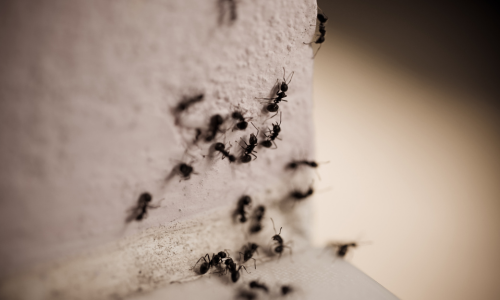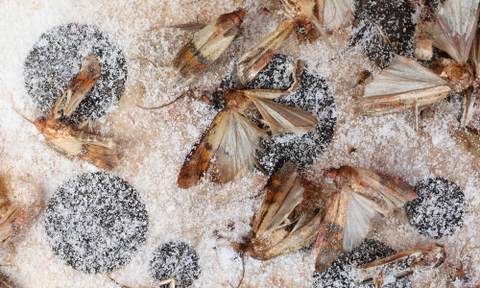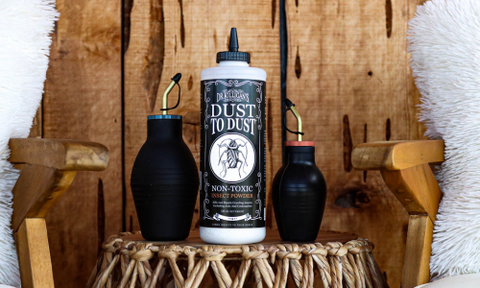We all stock up on items—whether it be because of a sale, the threat of severe weather or the fear of a shortage. I can understand, as I don’t like to miss a day without sprinkling flaxseed, with its mild and nutty flavor, over my hot cereal in the mornings. Nor can I imagine going a day without a steaming cup of biting hot, black coffee.
But, having a pantry full of grains, cereals, nuts and flours (and that’s just my top shelf) can be problematic. I have to ask myself: What measures should I take to protect my foods from insects? I have had trespassers before. Will they trespass again?
>>> Get a FREE sample of our best-selling, non-toxic insect spray
What items do pests infest?
If your pantry is filled to the brim with baked beans, stacked cans of tuna, canned soup and tomato paste, you’re in the clear. There’s not much that a pest can do with a can, just as there’s not much you or I could do without a can opener. But if you have boxes of macaroni and cheese, crunchy packets of your favorite cookies, granola bars, dried beans, tea, chocolate, spices, cured meats or bags of basmati rice lining your pantry shelves, you’re not in the clear.
These items attract an array of predators. Among the most common pantry pests are ants, cockroaches, pantry moths and weevils, each with unique infestation habits. Let’s delve into what each of these pests infests:
What do ants infest?

Ants are opportunistic feeders known to invade pantries and can be particularly attracted to sweet and starchy items. Different species of ants have preferences for various foods. For instance, sugar ants and pharaoh ants, typically found in kitchens, are drawn to sugary foods like syrup, honey and candies, whereas carpenter ants prefer proteins and fats, often targeting meat, pet food and grease.
For more detailed information, read Ants are everywhere. Here's what to know and where to turn.
What do cockroaches infest?
These greasy-looking insects will eat anything: starch, sugar, grease, meat and cheese, as well as rotting fruits and vegetables. As if it couldn’t get any worse, they also love cardboard, especially if it’s wet. They’ll use it for shelter and food, eating the fibers and glue of the organic material.
Roaches are also attracted to clutter and moisture, making any damp and cluttered spaces like basements and under sinks prime hiding spots.
For more detailed insights, read Common cockroaches and where you'll find them.
What do moths infest?

Pantry moths typically infest dry goods such as flour, pasta, grains, spices and pet foods, often targeting improperly sealed containers to access these staples. Beyond these, they are also known to invade dried fruits, nuts, chocolates and candies, which provide the necessary nutrients for their larvae. These moths are particularly drawn to any foodstuff that offers a high carbohydrate or sugar content, making even your baking mixes and powdered milk vulnerable to infestation.
For an in-depth exploration of pantry moth habits, refer to the article What do pantry moths eat?.
What do weevils infest?
These long-snouted, strange-looking insects primarily feed on grains and are often found in boxes or bags of stored whole-grain cereals and grains. Their favorite delights are raw seed grains; they tend to stay away from highly processed grain products. The most susceptible foods include raw wheat, oats, barley, rye, rice and corn.
For detailed strategies on preventing these and other pests from invading your pantry, explore 8 ways to ensure you never again see a bug in your pantry.
Does your home have signs of bugs at play?
Look for clues of a bug issue or a possible infestation. Many times, seeing one offender—or signs of one offender—means that there’s a pest party somewhere in your home. Ask yourself: Have you seen any of these creepy crawlies?
Do you have ants?
Ants aren’t sneaky fellows. You’ll see them and their friends. Ants leave behind a chemical trail that returning ants can follow later. If it’s carpenter ants you have, you’ll see small piles of sawdust or notice frass—a mixture of wood shavings and insect parts—which is a clear sign of their nesting inside wood structures. On the other hand, sugar ants and pharaoh ants often form trails towards spills, sticky residues or damp areas that are less noticeable but crucial signs of their presence.
To learn more about how to deal with these chemical trails effectively, read How do you get rid of ant trails?
Do you have cockroaches?
Roaches are filthy, leaving a trail of tiny dark brown dots—their feces—or smear marks—roach stains or liquified roach poop—for us to follow. You may also see their egg capsules, which can hold up to 30 nymphs and are shaped like a pill. Tip: These capsules are often found in hidden areas, like behind furniture or in wall crevices, serving as a discreet yet alarming sign of an infestation.
Additionally, cockroaches can produce a musty odor that becomes noticeable as their numbers increase. This scent, combined with their chemical trails, aids other roaches in returning to the newfound food source. For detailed strategies on addressing these issues, explore How to get rid of cockroaches.
Do you have moths?

Pantry moths— or Indian meal moths— are often detected by the telltale signs they leave behind. You may notice their pale gray wings fluttering in zigzag patterns near food storage areas. Their eggs—although tiny and nearly invisible—can sometimes be found clustered in pantry corners or on the undersides of shelving. More conspicuously, their larvae appear as small, grayish-white worms wiggling among your stored food products.
Look for larvae nestled in the creases of packaging, tucked into the rims of jar lids or burrowed in the corners of your cabinets. They are known to chew through cardboard, paper and even thin plastic to access food, often leaving behind a web-like material in the food products they infest.
For more detailed insights on effectively dealing with these pests, explore How to get rid of and prevent pantry moths.
Do you have weevils?
For weevils, particularly evident in grain products, several clear signs can indicate an infestation. If you’re pouring whole-grain oats or another cereal grain into a pot of boiling water and tiny brown bugs emerge, you've encountered active adult weevils caught in the act.
Another common sign is opening a bag of grains like short-grain brown rice and noticing a dry, dusty residue. This residue, often from the hulls of seeds, is a telltale indicator of a weevil’s nesting site for their eggs, larvae, and pupae. When such grain is added to water, this dusty material usually floats to the surface, signaling contamination.
Beyond these scenarios, be on the lookout for:
- Holes in grains or seeds
- Visible larvae or adult insects in unopened packages
- Webbing or clumping in flour or other milled products
How do I rid my pantry of insects?
Use diatomaceous earth or Dust to Dust for ants, roaches and weevils

Diatomaceous earth is a well-known natural insecticide that dehydrates insects upon contact. However, for an even more effective solution, consider using Dr. Killigan’s Dust to Dust Plant-Powered Insect Powder. This product offers similar benefits but with enhanced efficacy, boasting kill times up to 50% faster than standard diatomaceous earth.
To rid your home of these pests, first ensure that the areas you want to treat are dry and clean. Utilizing Dr. Killigan’s Insect Buster Bulb Duster, evenly spread a thin coat of Dust to Dust on surfaces and in crevices where you've observed insect activity. Focus on dark areas where pests are likely to hide and find food, such as behind stoves, refrigerators and other appliances. Also, target their entry points, including cracks, gaps and outlets around wiring. Treat any wall voids—like cracks or holes leading into the walls. After treatment, repeat as necessary to ensure a pest-free environment.
Dust to Dust is non-toxic and non-poisonous, making it a safe alternative to traditional insecticides. It is safe for use around humans and pets. The Insect Buster, designed for ease of use and storage, allows you to accurately dispense Dust to Dust into cracks and crevices that are otherwise hard to reach with conventional sprays.
Use Dr. Killigan’s pantry moth traps for moths
Place three of Dr. Killigan’s Premium Pantry Moth Traps around the infested area in a triangular or web-like formation. Our traps are designed to attract the adult male moths to completely stop the life cycle of the pantry moth. Once your problem is under control, toss them and keep one trap out, changing it every three months. This is a preventative measure to keep any new moths from gaining a foothold. Note: Once opened, the traps are good for three months.
These traps are toxic-free and the pheromone is mixed right into the glue. They are a simple trifold design and have a stylish, classy look.
Use Dr. Killigan’s Six Feet Under for ants, roaches, moths, weevils and more
If you’re on the hunt for a superb kill-on-contact solution, use Dr. Killigan's Six Feet Under Plant-Powered Insect Spray. It is a popular kill-on-contact toxin-free spray that will dispose of most insects.
It does not contain pyrethrin or pyrethroids and is made with a mixture of clove and cottonseed oils that is 100% safe to use around pets, children and food areas of your home.
How do I protect my pantry from bugs?
Regardless of whether or not you currently have pesky invaders in your pantry, it’s time to take action. Today is the day.
Throw away infested product

Investigate, toss and investigate and toss again. Rid your home of all infested products and then inspect your cupboards, your pantry shelves and all food items for any intruders and their larvae. Given the chance, many of these insects will snack on almost anything. Look for evidence in and on all food packaging. Check grain-based products like flour, cereal, pasta and baking mixes, along with nuts, seeds, sweets and powdered milk, though all dry good packages should be inspected. If you have pets, be sure to check their food too.
Following a deep cleaning, spray Six Feet Under on your pantry shelves and walls, followed by wiping down every shelf, the sides of every walls and each container, can and package. This will ensure that no eggs or larvae were missed.
Refrigerate or freeze stored foods
If a food item is open, you do not necessarily have to toss it. A quick inspection from the outside of the packaging should tell you whether or not an individual food item needs to be trashed. If there are no signs of insects or their feces, do not throw it out. If you have any doubts, wrap the item in a sturdy plastic bag and place it in the freezer for 48-72 hours. In the event you were wrong, the cold will ensure that you have no survivors.
Place stored items in sealed containers
Purchasing plastic, glass or stainless steel containers with airtight lids is worth the investment. Ensure that your goods remain bug-free. These containers will keep insects out better than cardboard, paper or foil wrapping.
Monitor your pantry for pest activity
Clean your pantry every three to six months. This will help keep you organized and will keep pests at bay.
The final word on pantry protection
Our team of professionals is dedicated to perfecting the art of Killing Them Softly®. We have designed 100% toxin-free pest control products that are not only safe but are also created with style, restoring peace of mind and returning classy to your home.
We are continually raising the bar in toxin-free pest control remedies. All our products come in a design that is pleasing to the eye and carry a 100% satisfaction guarantee. If you are not satisfied for any reason, please contact us. We will not hesitate to make things right.





















